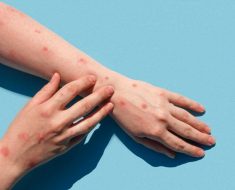A new episode of our podcast, “Show Me the Science,” has been posted. At present, these podcast episodes are highlighting research and patient care on the Washington University Medical Campus as our scientists and clinicians confront the COVID-19 pandemic.
Infections with the virus that causes COVID-19 are not the only cause of pandemic-related hospitalizations. Although children tend to be at lower risk of COVID-19, the number of kids with mental health and behavioral problems has exploded during the pandemic, driving an increase in pediatric hospital admissions nationwide. Stressors associated with remote schooling, fear of infection, and concern about older relatives have contributed to a tidal wave of hospital admissions for psychiatric issues, according to John N. Constantino, MD, the Blanche F. Ittelson Professor of Psychiatry and Pediatrics, and director of the William Greenleaf Eliot Division of Child & Adolescent Psychiatry. Constantino, also psychiatrist-in-chief at St. Louis Children’s Hospital and co-director of Washington University’s Intellectual and Developmental Disabilities Research Center (IDDRC), says virtual schooling has contributed significantly to the problem. He says it’s important to get back to normal learning routines, particularly for kids with special needs. In the St. Louis area, the return to in-person schooling for such students has been made possible partly due to a COVID-19 testing program in St. Louis County’s Special School District. That testing effort is being coordinated by the other IDDRC co-director, Christina Gurnett, MD, PhD, who is also director of the Division of Pediatric and Developmental Neurology and neurologist-in-chief at Children’s Hospital. She says that ensuring schools are safe and getting kids back into more normal routines can help reduce the need to hospitalize kids for psychiatric and behavioral issues.
The podcast, “Show Me the Science,” is produced by the Office of Medical Public Affairs at Washington University School of Medicine in St. Louis.
Transcript
Jim Dryden (host): Hello and welcome to “Show Me the Science,” conversations about science and health with the people of Washington University School of Medicine in St. Louis, Missouri, the Show-Me State. As we continue to detail Washington University’s response to the COVID-19 pandemic, we look at the effects the pandemic is having on children. Although it is true that kids have a lower risk of getting sick from the coronavirus itself, the stressors associated with the pandemic have been taking a toll, particularly on children with special needs. Dr. John Constantino, a child psychiatrist and one of the directors of the Washington University Intellectual and Developmental Disabilities Research Center, says changes related to school during the pandemic have had a particularly detrimental effect.
John Constantino, MD: Whether it’s intellectual disability, whether it’s severe attentional difficulties, whether it’s the required social interpersonal motivation to engage in school and academic work. But even children who can utilize these virtual methods for learning have experienced extraordinary kind of stressors during the pandemic.
Dryden: Constantino says pandemic-related stressors have contributed to a doubling or tripling of psychiatric inpatient populations at children’s hospitals around the country.
Constantino: It is inducing a kind of reckoning with some of the major existential issues that all adolescents struggle with at some level: the fragileness of life versus death, the notion of how much power one has over — and agency — over one’s own course. The consequence of this kind of intensification of existential issues that are the playing field for identity development in adolescence has been very hard on many teenagers.
Dryden: Constantino, the psychiatrist-in-chief at St. Louis Children’s Hospital, says pandemic-related stressors have been particularly hard on kids with special needs which has sparked a study involving those kids, their teachers, and other personnel in special schools who are now being tested regularly to make sure the schools are safe and to allow kids with those special needs to return to the classroom. Dr. Christina Gurnett, who co-directs the Intellectual and Developmental Disabilities Research Center, is helping coordinate that study.
Christina Gurnett, MD, PhD: When we proposed this study and to get funding to do the surveillance testing in the schools, we actually weren’t sure the schools would be open at all. And we were really fortunate that the Special School District opened about four weeks before Thanksgiving last year, and that’s around the time we secured the funding to be able to go into the six schools associated with the Special School District and offer weekly surveillance testing to the staff at the school. And more recently, we’ve been rolling out testing for the students.
Dryden: The issue causing stress for most kids is the same as it is for the rest of us. Constantino says a lack of control combined with a loss of what’s normal has made it difficult for everyone.
Constantino: There have been many losses particularly of grandparents and close loved ones from the pandemic. There have been monumental stressors at home. If you just really catalog the kind of in-home stressors of a young family or a family with multiple children, if you think about generally what the level of stress, complexity, conflict, difficulty that would superimpose on children with tendencies to depression, anxiety, psychosis, and because there are fewer external eyes and ears on their well-being, on markers of stress beyond their ability to cope. One of the other things that has happened is that the usual system for safeguarding children with respect to child abuse and neglect has very much been compromised, and the reporting rates have plummeted during the pandemic because there have not been these sort of checks and balances to identify risk situations that should be reported and for which families need help and need support. And so for all of those reasons — the home stressors, the very sad situations where home environments have bubbled over into either overt abuse or neglect that goes undetected — all of these have been hazards and so this has turned into hospitalizations.
Dryden: I’m also guessing that a child who would regularly see a mental health professional prior to COVID might not have been able to have as many appointments, those virtual doctor’s appointments that some of us have had with our primary care doc, they’re just not getting what they need in terms of the contact because there isn’t any contact.
Constantino: There is an irony about that. One of the remarkable silver linings of the pandemic has been literally a wholesale conversion of outpatient mental health practice to telehealth over the course of the pandemic. Now what many people would say about telehealth and mental health is that the fields of psychiatry and psychology have kind of grudgingly dragged their heels for, now, a decade. The infrastructure for broad implementation of telehealth has really been available, and it’s been a sluggish uptake of fears about, “Well, what’s it really going to be like for a patient?” and “Can you really take good care of of a patient using telehealth?” And many of our telehealth colleague researchers have been telling us for over a decade that telehealth is just fine for mental health, but a lot of people in the field didn’t believe that and didn’t endorse that and didn’t implement that. Well, it kind of reminds me of the saying that everybody’s got an opinion until they get punched in the face. I don’t know who said that, but there’s a famous saying about that. But the pandemic punched us in the face. And what everyone did in mental health, everyone, wholesale converted to telehealth. So the outcome of that has been that although some of the mental health visits really are not adequate to be done virtually as opposed to in-person, I would say that that is probably 15% or less of all of the visits. And the rest of the amount of mental health care has been affected very well through virtual methods. Number one, the patients actually love it because it’s more convenient for them. It abrogates the problems that some families have with transportation. It’s very difficult for families who don’t have good internet connections, of course, and that’s still sort of a disparity. An infrastructure disparity that has health and mental health consequences. But essentially what’s happened is that if you ask most child psychiatry services around the country, we’ve actually had about a 30% increase. And because of the efficiency of doing things virtually and because of the actual kind of reduction in missed appointments and so forth, there has been literally an increase in the amount of mental health care delivered as a result of the pandemic. One other thing I want to mention about the pandemic which is true I think for all of us is that it has induced a kind of reckoning with some of the major existential issues that all adolescents struggle with at some level: the fragileness of life versus death, the notion of how much power one has over — and agency — over one’s own course, the extent to which one is connected with the rest of the world around you. And all of these instances of just remarkable levels of isolation and social isolation. The consequence of this kind of intensification of existential issues that are the playing field for identity development in adolescence has been very hard on many teenagers. And so it’s tough enough to think about “How do I fit into the world?” But when the world is in a situation where adolescents are relegated to a hunkered-down place, isolated, not really able to work and contribute, having to be kind of have their lives placed on hold, has for some felt like a sort of indomitable level of being overwhelmed by the kind of harsh realities of life. And this has had a hard toll on many kids who are sort of thoughtful and thinking about at that stage of life, “Who am I? Where do I belong?” And that’s been another angle on the difficulty with the pandemic.
Dryden: Now, you were part of a big statement that was published in the American Journal of Psychiatry at the start of this school year, talking about how kids with special needs really needed in-person school. Scientists are very precise. But I mean, can you assume that they’re not getting what they need in school online or in hybrid school, and that is leading to these other issues that are requiring hospitalization in some cases?
Constantino: It’s a great question. Initially, it was a prediction based on— so that statement was a prediction based on what we knew the pandemic was doing to change the experience of these children and their families, not only with respect to their education, but the stressors on the families with everybody at home trying to learn virtually, trying to keep the kids on track with a structured routine when one of the most remarkable kinds of effects of the pandemic has had to do with children with developmental disabilities who have been relegated to daily schedules and forms of education and downgrades in the usual level of support from support staff and in-home therapies, etc. The student-teacher ratios for children in these higher needs settings educationally are on the order of two-to-one, three-to-one, and sometimes even one-to-one. And if you extrapolate that to parents at home trying to bring about the same level of support for education through a virtual medium and with the needs of the other children in the family having to be met by the same parent, it was just impossible to do. And what happened was that all of that came home to roost. It did create these stressors on the kids. And now there is absolutely evidence from a host of studies now in the COVID era that have looked at the behavioral outcomes and the impact of COVID on behavioral disability in this population, and certainly it has rampantly risen across the board. There have been a flood of hospitalizations of children over and above the usual base rate for this particular population.
Dryden: And is it these children that started with a developmental disability that are primarily making up that census, or is it anxious kids or just a matter of stressors being added to the underlying problems until the situation just can’t continue without a serious intervention?
Constantino: It’s fully both. So one of the more obvious, difficult situations incurred by the pandemic has been the consequences to children who already have developmental disabilities and who really cannot utilize the virtual media that have been used to essentially substitute for in-person learning whether it’s intellectual disability, whether it’s severe attentional difficulties, whether it’s the required social interpersonal motivation to engage in school and academic work. But even children who can utilize these virtual methods for learning have experienced extraordinary kind of stressors during the pandemic.
Dryden: And so I guess that suggests that these kids who have problems that require special attention, some sort of special attention, are more vulnerable because they haven’t been able to get some of that special attention?
Constantino: For that subset of children which is about one in six children in the population, actually, when you think about what the scope of developmental disability is, the pandemic has had very significant consequences on their mental health and well-being. And so what we’ve been seeing with them is a tendency for frustration to build, difficulty communicating about things that are changed and different about their lives. And as the frustration has built and as the constraints have dragged along, many of the children have had significant deteriorations in their behavior. Lashing out, acting out, getting disorganized in their thinking in ways that has required very intensive levels of care. And one of the things that we’ve been doing to try to counter that through the work of our Intellectual and Developmental Disabilities Research Center at WashU has been to partner with the schools in St. Louis County that serve some of the highest needs children with developmental disabilities and learning problems, and to make the school environment safe enough through repeated saliva testing of children, staff, teachers, such that we can get a resuming of the education for these higher needs children and getting them back to the entire curriculum that they had been accustomed to which has been a really important thing to do. And that’s been led by one of my close colleagues, Dr. Chris Gurnett in the Department of Pediatrics at Children’s.
Dryden: Gurnett, who is a pediatric neurologist, has been one of the coordinators of an effort to test staff and students at special schools in St. Louis County using a saliva test for COVID-19 that was developed by Washington University researchers last summer.
Gurnett: We really became aware that this was a huge problem because our patients were coming in and telling us that they’ve not been in school for six months now, many of them have not been in school for a year, and we knew that Washington University had been developing a really great saliva-based test for the coronavirus that would be very palatable to a special needs population and it’s something that you could do in the schools. And I feel really strongly that we should be out in the community taking things that we develop here at Washington University and making our community better. And one of these would be bringing the same test that we brought to the undergrads at the Washington University community who are getting surveillance testing every two weeks. This particular project with the St. Louis Special School District would allow us to bring this surveillance testing to that classroom setting.
Dryden: And many of the children involved in this project that would use the testing have had a tough time with any sort of virtual or hybrid models of learning. What are you finding so far in terms of keeping things safer due to the testing or is it too early to tell?
Gurnett: I think we were really fortunate here in St. Louis compared to the coasts. It seems that more of the schools have been able to stay open. We actually weren’t sure the schools would be open at all. And we were really fortunate that the Special School District opened about four weeks before Thanksgiving last year, and that’s around the time we secured the funding to be able to go into the six schools associated with the Special School District and offer weekly surveillance testing to the staff at the school. And more recently, we’ve been rolling out testing for the students.
Dryden: There are a lot of special needs children, however, who’ve been mainstreamed and are in other schools. Are there any plans to expand these sorts of testing efforts beyond those six schools in the Special School District?
Gurnett: The Special School District of St. Louis County provides services to many different school districts throughout the county. So I think there’s something like 24,000 students who get special services. We decided we really would focus on the Special School District where the kids with the most severe disabilities are seen every day knowing that that’s really probably the highest risk environment that a school could pose. I mean, we knew that those kids can’t necessarily mask as well, and social distancing is a lot harder in those cases because they need help with feeding and other kind of daily cares.
Dryden: I know we want to be as protective of kids with special needs as possible and we want them to have the services they need, but we also don’t want them getting the virus either. It’s quite a dilemma for researchers and caregivers.
Gurnett: It is. These kids are definitely at high risk of mortality and hospitalization, and some of the data that’s out suggests 20 to 30 times higher than typically developing kids. Actually, the teachers and the staff and administrators in these schools are really committed to the safety of these kids. And that’s what really became quite clear was that they made sure that the teachers were wearing masks. And if they couldn’t wear masks or if the students couldn’t wear masks, they brought in the face shields which would be an alternative kind of mitigation strategy. There was a big commitment to make sure that there were no corners cut. There weren’t staff parties or any kind of food or birthday parties. All the kinds of things that normally happen in schools just couldn’t happen. It’s never going to get the risk down to zero, but there are some good mitigation strategies that we learn from them.
Dryden: And the overall goal is to keep kids who have special needs in school in school. That’s the way to keep them from deteriorating and from confronting other issues that might land them in a hospital.
Gurnett: And I think what we’ve been able to do is take what we’ve learned from the Special School District and start to tell other school districts that are still opening or just opening now, what are those strategies that can be helpful.
Dryden: Gurnett and Constantino say the loss of in-person school and support has been one of the main contributing factors to the increases in inpatient populations at children’s hospitals around the country. The solution, they say, is to keep finding better ways to deliver necessary services to the children who need them the most. “Show Me the Science” is a production of the Office of Medical Public Affairs at Washington University School of Medicine in St. Louis. The goal of this project is to keep you informed and maybe teach you some things that will give you hope. If you have enjoyed what you’ve heard, please remember to subscribe and tell your friends. Thank you for tuning in. I’m Jim Dryden. Stay safe.
Source: Read Full Article




